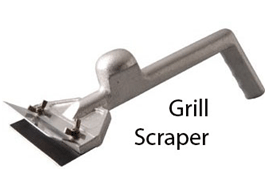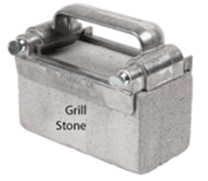


General use and maintance for Teppanyaki Table
General instruction for use:
Opening:
-
Switch the main power wall switch on
-
Switch the teppanyaki power on the table switch this will differ greatly between models and could be split into 2 or even 3 sections so decide how many sections you need to heat
-
Use the slider or the temp control knob to set the temperature to heat up ready for cooking again this can vary from model to model but the temperature for minimum cooking should be around 180c then can be turned up as you begin cooking or if you find it is busy you shouldn’t exceed 250c as it will be more likely to burn the food before it is cooked through and may damage the machine
-
During cooking it is important to use a little oil first to prevent the foo from sticking, try to only turn the meat dishes once during cooking as this process will help prevent the meat from drying out.
-
After each dish cooked it is important to use the paddles to scrape down the table for and remaining food bits so future batches remain clean and that the table looks clean and fresh to the customers always wipe down all areas with blue roll as the oil can splash and cause the area to look dirty and unpleasing to the eye.
-
After several batches it will be necessary to use the griddle scraper tool to give the table a good clean down
-
When cooking noodle dishes and some meat or seafood for best results use the water and teppanyaki hat to help to steam the product this will speed up cooking and again retain moisture this method should not be employed on steak dishes though.
Closing:
-
Thoroughly use the griddle scraper scrapping iron to scrape down the entire table removing as much burnt on colour and food as possible, then wipe down with blue roll
-
Switch off the teppanyaki table and allow to cool to approx. half as hot as it was for cooking
-
Pour over a little at a time some water (not too quickly as you don’t want to shock the element)
-
Once you are able to have a good coating of water without it all steaming away begin the cleaning process
-
Firstly use the Griddle scrapper another good scrape and bring up any further particles released by the water and again clean down with blue roll
-
Now get out the griddle stone machine and moving always in the same direction (the direction of the tiny grooves in the steel) move the stone up and down in a constant rubbing motion applying pressure to the stone continue doing this whist mopping up with blue rollm and adding little amounts af water if necessary until all the built up black marks are removed and the table is now dry and shiny
-
Give it a final wipe over with blue roll and just a touch of oil to give it a slight covering to prevent it rusting overnight and it is done
-
Operating temperature(TBA)
cooking 220C
standy: off
Cleaning Teppanyaki table
-
Thoroughly use the griddle scraper scrapping iron to scrape down the entire table removing as much burnt on colour and food as possible, then wipe down with blue roll
-
Switch off the teppanyaki table and allow to cool to approx. half as hot as it was for cooking
-
Pour over a little at a time some water (not too quickly as you don’t want to shock the element)
-
Once you are able to have a good coating of water without it all steaming away begin the cleaning process
-
Firstly use the Griddle scrapper another good scrape and bring up any further particles released by the water and again clean down with blue roll
-
Now get out the griddle stone machine and moving always in the same direction (the direction of the tiny grooves in the steel) move the stone up and down in a constant rubbing motion applying pressure to the stone continue doing this whist mopping up with blue rollm and adding little amounts af water if necessary until all the built up black marks are removed and the table is now dry and shiny
-
Give it a final wipe over with blue roll and just a touch of oil to give it a slight covering to prevent it rusting overnight and it is done
Maintaining Teppanyaki
In order to prolong the life of the Teppanyaki and cut down on down time and needed repairs you need to follow the points below:
-
Clean the teppanyaki table regularly
Your teppanyaki table will need to be cleaned regularly during the night in between dishes to ensure the quality of the dishes are good without bits becoming stuck, the teppanyaki looking messy and problems with cross contamination, you should also keep all sides and front wiped down and look after the teppanyaki, also ensure to always wipe over with a paper towel and little oil at the end of cleaning to prevent any rust building up on the surface overnight
-
Switch off the teppanyaki when cleaning
The teppanyaki needs to be switched off and allowed to cool a little before the deep end of night clean to prevent burns from the evaporating steam, also to prevent any damage of shock to the very hot table by the addition of water for cleaning
-
Inspect the teppanyaki
Regularly inspect the teppanyaki table for correct heating, loose wires and various other problems that could arise
-
Report any problems immediately and switch off to avoid further damage or problems
-
Turn down or off when not in use
To prolong the life of the teppanyaki as well as save on running costs always turn your teppanyaki down when not in use or switch off if not needed for longer periods of time
Teppanyaki safety
The Teppanyaki table used in all our branches on the open kitchen is considered a moderate risk but can cause some very severe injuries if not used correctly and safely. Always ensure you have been trained and supervised in the safe use of the equipment and cooking techniques and methods before using the teppanyaki by yourself.
Safe use of teppanyaki
-
Ensure ventilation is working correctly to control intake of fumes and environment
-
The teppanyaki table gets extremely hot, it will have a central hot spot or in some cases dependent on model controlled sections with a central hot spot, from here out to the sides it will get cooler, Do Not Touch any of the surface of the hotplate as it will burn you, just in lesser degrees of severity.
-
Always use the delegated paddles for cooking and moving around the products, use of other equipment can pose a risk to user.
-
When first adding the oil to the surface, be aware of spits from the hot oil.
-
When adding ingredient’s to the table always use tongs directly from a plate to avoid drips on the hot surface or anywhere else and never with hands, do so at arm’s length to avoid being caught by hot spits of the oil.
-
After being trained and shown how to safely produce the flames on the teppanyaki, care must always be taken for both your safety and that of the customers when using this flair, always alert the customer first and ask them to stand back! Delegate the safe area on the teppanyaki as far back from the customers as possible, use a long cooker lighter to ignite not a small personal lighter. Use the oil and wine sparingly too much could result in an out of control flame. Ensure surroundings are clear of potential hazards before proceeding.
-
When adding water to noodles etc. be aware of the resulting ploom of steam that if your arms or hands are in the way could cause burning.
-
Be aware when using the stainless steel covering lids that these handles will get hot, either use the paddles to remove the lid or a piece of blue roll to protect fingers.
-
Do Not leave paddles or lids on the surface when not in use as they will get very hot, then burn you or another member of staff when picked up to be used again.
Safe Cleaning of teppanyaki
-
Switch off the teppanyaki before cleaning and allow to cool as long as possible
-
Dose with water to aid the cooling, and aid in the cleaning procedure
-
When using the sanding block to clean the table use a cloth to protect your hands from the heat whilst holding
-
Do Not touch any area of the surface while still hot during cleaning.
-
Ensure the canopy is cleaned frequently once or twice per week minimum this will ensure no build-up of grease that could have a danger of igniting especially when doing the fire flair procedure.